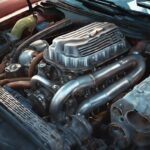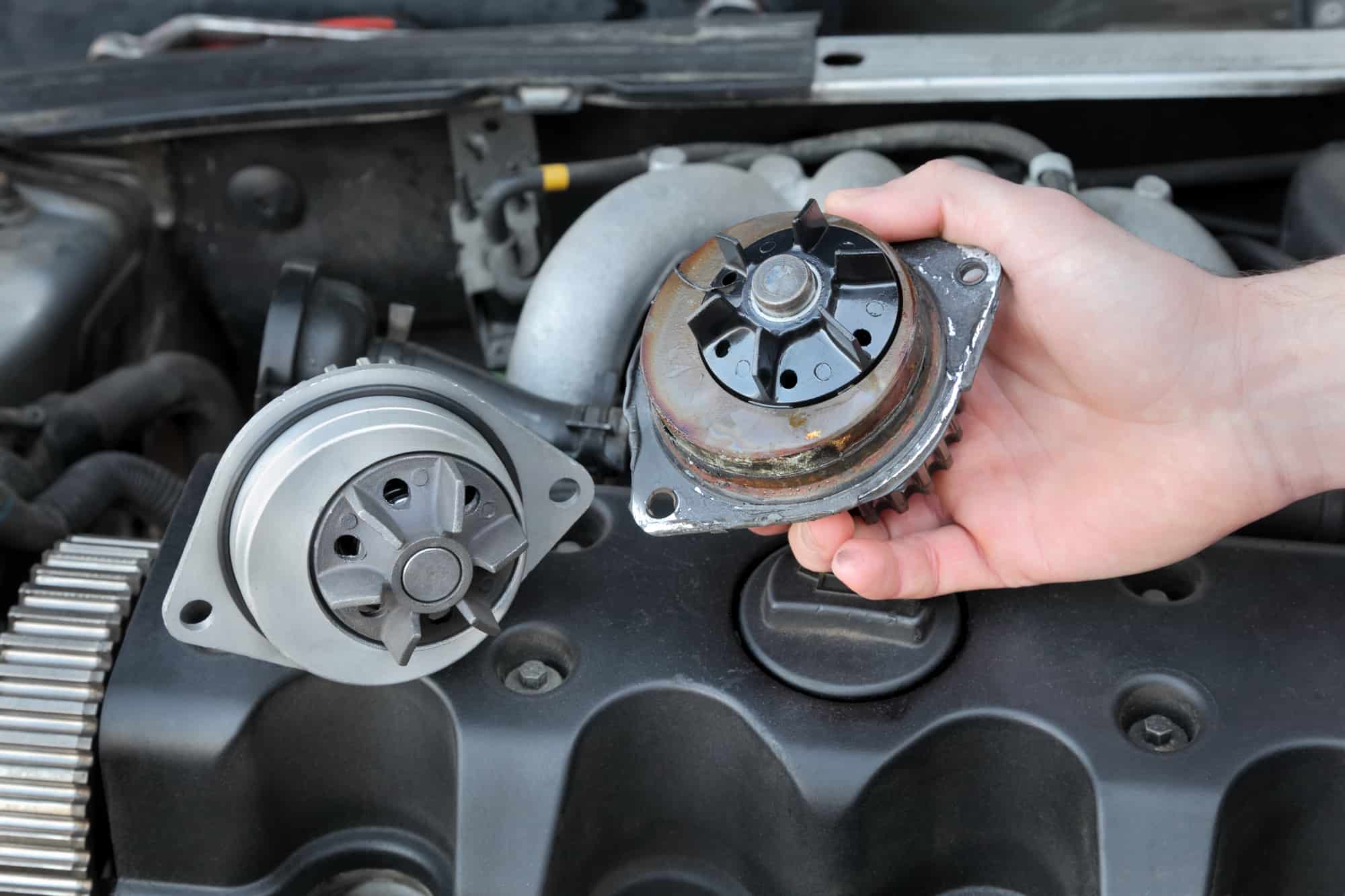Your car’s water pump plays a crucial role in maintaining the right engine temperature by circulating coolant throughout the engine. When the water pump is functioning properly, it prevents the engine from overheating and ensures smooth operation. However, a faulty water pump can lead to a variety of issues, but can it cause a loss of engine power?
Yes a bad water pump can cause a loss of engine power. If the water pump is not functioning properly, it may not be able to pump sufficient coolant through the engine, which can cause the engine to overheat. Overheating can cause damage to the engine’s gaskets and seals, which can lead to oil leaks and reduced engine power. Additionally, an overheated engine can cause detonation or knocking, which can reduce engine power and damage the engine.
Water pump failures may not be immediately noticeable, but they can escalate and affect other components surrounding the pump. When a water pump is bad, it can result in leaks, coolant loss, and eventually, engine overheating. It’s essential to be aware of the early signs of a failing water pump, such as coolant leaks and strange noises, to prevent further damage to the engine and related systems.
As an Amazon Associate we earn from qualifying purchases.
Does A Bad Water Pump Affect Engine Performance?
A bad water pump can cause loss of engine power and can adversely affect a vehicle’s performance. This is because the water pump helps keep the engine running at normal operating temperature and works in hand with the thermostat.
When the water pump goes bad, it can also leak coolant into the bearings of the water pump, which can dry out the bearings of grease and create a squealing noise when the engine is running.
If the water pump fails completely, it will not be able to circulate coolant through the engine block, resulting in an overheating situation and additional engine damage like cracked cylinder heads, pushed head gaskets, or burnt pistons.
Brief Overview of a Water Pump
A water pump is a crucial component in a vehicle’s cooling system, responsible for pumping coolant through the engine block, ensuring its temperature remains stable when the engine is running. It helps prevent the engine from overheating, which can cause extensive damage and lead to poor engine performance.
How Does A Water Pump Typically Fail?
A water pump can fail in several ways, including:
- Leaking: The water pump has a gasket that can wear out over time, causing coolant to leak from the pump.
- Bearing failure: The bearings in the water pump can wear out or become damaged, causing the pump to make a whining or grinding noise.
- Impeller damage: The impeller is the part of the water pump that circulates the coolant. If the impeller becomes damaged or corroded, it can’t move the coolant effectively and the engine can overheat.
- Seal failure: The water pump has a seal that keeps the coolant from leaking out of the pump. If the seal fails, coolant can leak out and the pump won’t be able to circulate coolant effectively.
- Belt failure: The water pump is driven by a belt or a chain. If the belt or chain breaks, the water pump won’t be able to circulate coolant and the engine can overheat.
Why does a failing water pump cause loss of power?
A bad water pump can lead to a loss of engine power and the main reason for this is the potential for overheating, which can cause multiple negative effects on an engine’s performance. An overheated engine can cause damage to vital components such as the head gasket, cylinder head, and pistons.
Driving with a faulty water pump puts extra stress on the engine and other surrounding components, leading to increased wear and tear. This, in turn, can result in reduced vehicle performance, and in some cases, complete engine failure if the engine block or cylinder head become damaged beyond repair.
What Are The Effects of a Bad Water Pump on Engine Power?
A bad water pump can have various negative effects on a vehicle’s engine performance, leading to a loss of engine power. Knowing the signs of a failing water pump can help you to minimise the damage that a bad water pump can cause.
1. Engine Overheating
One common issue that arises from a bad water pump is engine overheating.
A bad water pump can cause engine overheating in a few ways. The water pump is responsible for circulating coolant through the engine block, radiator, and heater core. If the water pump is not working properly, coolant may not circulate effectively, causing the engine to overheat. Here are a few ways a bad water pump can cause engine overheating:
- Reduced coolant flow: If the water pump is not working properly, it may not be able to circulate coolant through the engine block and radiator effectively. This can cause hot spots to develop in the engine, leading to overheating.
- Coolant leaks: If the water pump is leaking coolant, the coolant level in the engine may drop, causing the engine to overheat. If the coolant is leaking onto the drive belt, it can cause the belt to slip or break, which can lead to the water pump not working at all.
- Broken impeller: The impeller is the part of the water pump that rotates and pumps coolant. If the impeller becomes damaged or corroded, it may not be able to move coolant effectively, causing the engine to overheat.
- Failed bearing: The water pump has bearings that can wear out over time. If the bearings fail, the water pump may not be able to circulate coolant effectively, causing the engine to overheat.
2. Loss of Coolant Through Leakage
A faulty water pump may develop leaks due to internal or external corrosion. This can cause the loss of coolant, which is critical for maintaining an optimal engine temperature. A low coolant level can affect engine performance and potentially lead to overheating.
A bad water pump can cause coolant leakage in a few ways:
- Gasket failure: The water pump has a gasket that seals the pump to the engine block. Over time, this gasket can wear out, crack, or become damaged, allowing coolant to leak out of the pump.
- Cracked housing: The water pump housing is made of metal or plastic and can crack or become damaged due to age, wear and tear, or impact. If the housing is damaged, coolant can leak out of the pump.
- Corrosion: If the water pump is made of metal, it can corrode over time, causing leaks. Corrosion can be caused by a variety of factors, including the type of coolant used, high temperatures, and exposure to salt or other corrosive substances.
- Shaft seal failure: The water pump has a shaft seal that keeps coolant from leaking out of the pump. If the seal fails, coolant can leak out of the pump.
3. Poor Coolant Circulation
Contaminated or improperly mixed coolant can contribute to corrosion on the pump’s impeller. This internal corrosion affects the water pump’s ability to circulate coolant throughout the engine effectively, causing the engine to overheat and lose power.
4. Engine Damage Caused by Lack of Coolant
If a bad water pump causes coolant leakage and circulation issues, the engine may sustain significant damage. Potential issues resulting from a lack of coolant include cracked cylinder heads, pushed head gaskets, or burnt pistons, all of which negatively affect engine performance and power.
If the water pump is leaking coolant or the gasket that seals the pump to the engine block has failed, coolant may leak out of the pump, reducing the amount of coolant available to circulate through the engine. If the water pump is not working properly, it can cause hot spots to develop in the engine, leading to overheating and potential engine damage.
5. Belt Slippage
A bad water pump can cause belt slippage in a few ways. The water pump is driven by a belt or a chain, and if the water pump is not working properly, it may not be able to rotate smoothly. Here are a few ways a bad water pump can cause belt slippage:
- Leaking coolant: If the water pump is leaking coolant, it can get onto the drive belt and cause it to slip. Coolant can also cause the belt to deteriorate over time, making it more prone to slipping.
- Worn bearings: The water pump has bearings that can wear out over time. If the bearings fail, the water pump may not be able to rotate smoothly, causing the drive belt to slip.
- Corroded or damaged pulley: The water pump has a pulley that the drive belt wraps around. If the pulley becomes corroded or damaged, it may not be able to grip the belt properly, causing it to slip.
- Misaligned pulleys: If the water pump pulley is not properly aligned with the other pulleys in the engine, it can cause the drive belt to slip.
If the drive belt slips, it can cause a variety of problems, including reduced power steering assist, reduced alternator output, and overheating.
Signs of a Bad Water Pump (4 Top Symptoms)
There are several symptoms that can indicate a bad water pump, potentially leading to a loss of engine power. In this section, we will explore four common signs: Leaking Coolant, Noises, Check Engine Light Turned On, and Rising Temperature Gauge.
Symptom 1. Leaking Coolant
A failing water pump may cause coolant leakage from the axle sealing or gaskets. The water pump uses gaskets to ensure coolant remains sealed, and the flow of water is uninterrupted.
If you notice a green or orange liquid pooling under your vehicle, it may indicate a leak from the water pump.
Symptom 2. Noises
Unusual noises coming from the engine area can also signal a bad water pump.
This can be caused by a worn or loose bearing inside the water pump, which in turn creates a whining or grinding sound. Pay close attention to any unfamiliar sounds as these could be early warning signs of a failing water pump.
Symptom 3. Check Engine Light Turned On
If the water pump is not functioning correctly, it may trigger the check engine light to come on.
This is an indicator that the vehicle’s cooling system is not working efficiently, and the engine may be prone to overheating.
Symptom 4. Rising Temperature Gauge
A failing water pump can lead to an overheating engine, which may be apparent by a rising temperature gauge on the dashboard. This is because the faulty water pump is unable to circulate coolant through the engine block effectively, resulting in increased engine temperature.
Continued driving with an overheated engine can cause further damage to components, such as the head gasket, cylinder head, and pistons.
What Next – How To Diagnose And Repair A Failing Water Pump
1. Diagnosis
Diagnosing a failing water pump begins with checking for some common symptoms. These can include:
- Overheating engine
- Leaking coolant
- Low coolant levels
- Noises coming from the water pump area
First, check the temperature gauge on your dashboard. If the engine is running hot or the gauge is rising into the red zone, it might indicate a problem with the water pump.
Next, check for visible coolant leaks around the water pump or in the coolant reservoir. If you notice rusty water or a low coolant level, this may also point to a failing water pump.
2. Repair
If the diagnosis confirms a faulty water pump, it’s important to repair or replace it as soon as possible to prevent further damage to the engine. Here are the general steps for repairing a failing water pump, you’ll need to refer to a workshop manual for your specific vehicle, or hire a mechanic to do it for you.
- Allow the engine to cool down before attempting any repairs.
- Drain the coolant from the radiator and engine to prevent any spills during the repair process.
- Disconnect the negative battery cable to ensure safety while working on the engine.
- Remove any components obstructing access to the water pump, such as belts, hoses, or engine covers.
- Take off the old water pump by unscrewing the mounting bolts and carefully prying it away from the engine block.
- Remove any gasket residue from the engine block and water pump mounting surfaces.
- Install the new water pump by aligning it with the engine block and tightening the mounting bolts according to the manufacturer’s specifications.
- Reconnect any components previously removed, including belts, hoses, and engine covers.
- Refill the radiator and engine with a mixture of coolant and water according to the vehicle’s specifications.
- Reconnect the negative battery cable and start the engine to ensure proper operation of the new water pump.
FAQs
1. Does a bad water pump give a code?
No, a bad water pump typically does not give an OBD (On-Board Diagnostics) code on its own. However, if the water pump is leaking coolant or causing the engine to overheat, it can trigger other codes related to the cooling system or engine performance. For example, a coolant temperature sensor may detect that the engine is overheating and trigger code P0217. If the water pump is leaking coolant onto the drive belt, it can cause the belt to slip or break, which can trigger a code related to the drive belt or accessories.
2. When replacing a water pump what else should you replace?
When replacing a water pump, there are a few other components that should be inspected and may need to be replaced, depending on their condition:
1. Thermostat: The thermostat is responsible for regulating the engine’s operating temperature. If the water pump has failed, it’s a good idea to replace the thermostat at the same time, as it may have been damaged by the overheating.
2. Coolant hoses: The coolant hoses should be inspected for signs of wear, cracking, or leaking. If any of the hoses are damaged, they should be replaced.
3. Drive belt: The water pump is typically driven by a belt or a chain. If the belt is worn or damaged, it should be replaced at the same time as the water pump.
4. Radiator cap: The radiator cap should be inspected for signs of wear or damage. If the cap is not sealing properly, it can cause coolant to leak out of the system.
5. Radiator: The radiator should be inspected for signs of damage or corrosion. If the radiator is damaged or corroded, it may not be able to effectively dissipate heat from the coolant.
6. Fan clutch: If your vehicle has a fan clutch, it should be inspected for signs of wear or damage. The fan clutch helps to regulate the engine’s operating temperature by controlling the flow of air through the radiator.
As an Amazon Associate we earn from qualifying purchases.































What should I look out for to spot a failing water pump early and avoid severe engine damage?
I’ve noticed my car has been running hotter than usual and there’s been a decrease in performance. Could this be related to a problem with my water pump, and if so, how can I confirm it?